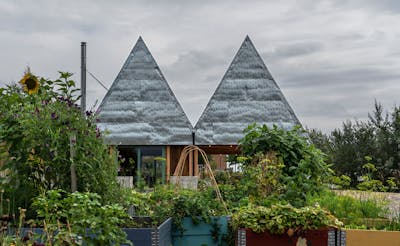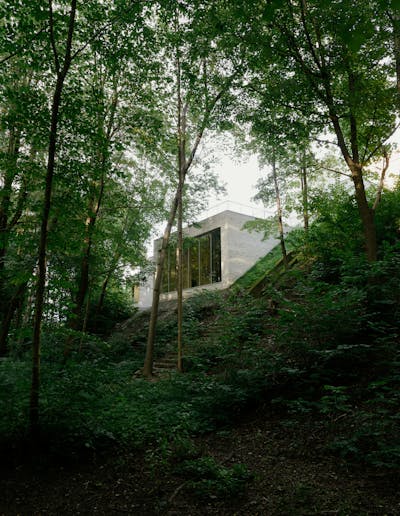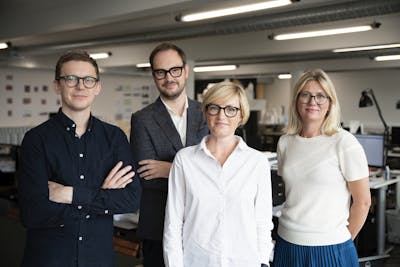Crossing borders for ten years
Interview with Transborder's founding partner Øystein Rø.

The pilot project Oslo Badebotaniske, demonstrates the possibility of nature restoration and sustainable material usage in underwater constructions. Made in collaboration with Oslo Badstuforening.
Transborder Studio look back on their first ten years in business with a retrospective exhibition.
Transborder Studio works with projects spanning from urbanism and architecture to interior. Transborder works in all scales, from smaller interventions to large urban projects, often with a unique combination of programme, context and history.
Founded in 2013 by Espen Røyseland and Øystein Rø after having operated the architecture and art gallery 0047 in Berlin and Oslo (also) for ten years, the partner group is today expanded to include also Siri Lundestad and Maja Egge Šipuš.
Long time partners and friends of the Triennale, Transborder is a part of the Oslo Architecture Triennale's guild of partnering offices.

Founding partner Øystein Rø, here photographed in a recent exhibition in Shanghai curated by the Oslo Architecture Triennale, where Transborder Studio were one of four invited offices.
Their anniversary exhibition Crossing New Borders opens Friday November 3 at Gamle Munch, last year's Triennale main venue, and showcases the office's past, present and future work.
Founding partner Øystein Rø finds time for a conversation in the middle of the preparation of the exhibition.
You point to the fact that the construction industry seem to fail to reach the neccessary green transition. Can you expand on this diagnosis – what is the problem?
The climate and nature crises represents an almost impossible challenge for the society at large, not to mention the construction industry in particular. We don't want to fall into a state of defeatism – on the contrary, with this exhibition we would like to show intentions on bringing about actual change. There are many intersting things happening within our business, which operates under a lot of pressure.
However, our experience after these ten years in operation is that short-term revenue seems to outweigh the ambition of doing something new and innovative. The industry has been streamlined through years and years to serve and benefit from the existing system. Thus, changing the business models, the power relations and the established networks poses a great challenge. As a small actor we can but try to be smart and identify cracks in the system through which we can make a difference. That is what this exhibition is all about.

The new House of Church in Oslo, which Transborder is commissioned to design. Located on the grounds of the city's historic hospital, the new complex will consist of transformed hospital buildings (the oldest dating back to the 18th century), new offices and an open arena for cultural activities, meetings, a cafe and exhibition areas.
Through your practice you show the potential that lies in experiments and pilot projects, and working with temporality or a more time-conscious approach. What is the potential of such an approach, the way you see it?
That you can address a problem in a small and understandable scale fairly quickly. It is easier for a client to join a temporary test arena than building a whole project in a new way. Pilots can also have several purposes in a project, and we see that the act of piloting creates competence, ownership and arenas for participation – all of these things that one generally wish for and, if done right, can become the fundament of new ways of doing things.
As such, the pilot projects become concrete future laboratories where action takes place. We genuinely believe in this way of working!

KLODEN will become an arena where professional performing arts and children and youth come together. Built up by youth alongside professionals, KLODEN will have an important function as an engine in the development of the surrounding district of Økern, Oslo.
The title of your exhibition being Crossing New Borders – what do you find to be the most important steps to take towards the architecture and construction of the future?
We like to believe we have only just begun to solve the big challenges in the world today, and that there will be made many new discoveries within the field of architecture in the years to come. The climate and nature crises spur radical changes in our profession.
Important going forwad will be finding smart networks and alliances for change, challenging the current hopelessly resource-demanding methods of construction and use of material, exploring the potensials of our existing buildings in new ways, as well as actually priotising and protecting biodiversity in our cities.
Being privileged enough to work with such questions, we of course would have wished to have found the answers already.

The temporary Nansenløkka community house will be replaced by a permanent one, a space dedicated to the community and urban agriculture. Made in collaboration with Dyrvik Architects, the community space will be an important meeting point for residents and visitors alike.
In what ways, then, can the exhibited projects be considered an expression of crossing new borders?
The title is an ambiguous one for us, referring to both the journey that our office has made up until today and going forward, at the same time as the exhibited projects illustrate how we as small actors can contribute to change in a large business with heavy stakeholders, where rapid change is difficult.
We have chosen to focus closely on three projects in particular that show these ambitions through pilotung: At Fornebu there has been an emphasis on circular strategies and the function og community spaces, in other words: social sustainability. This temporary project has grown to become Norway's largest urban agricultural project. The KLODEN pilot has acted as a testbed for a new theatre institution and engine of urban vitality in the east of the city of Oslo. Finally, Oslo Badebotaniske will demonstrate the possibility of nature restoration and sustainable material usage in underwater constructions.

In 2021, Transborder finished the extention of the Villa Grande, where The Norwegian Holocaust Center is located. The extention expands the existing exhibition space, creating a subtle framework for new narratives for minority groups in the world. Cultivating the edge of the 'castle plateau' with a low-key composition of volumes and openings, a new movement through history and landscape is created.
In your perspective, what is the most urgent actions needed in order for architecture and the construction industry to become more sustainable? What does it take?
That's a big question, but to try to give a short answer: We believe there is a need for fundamental systemic changes on several levels. A significant target will be to establish a system – a culture, even – that opens op to and rewards innovation.
In Transborder we are at least determined to proceed in exploring the possibilies and opportunities that lies in crossing big and small borders.

The partners of Transborder Studio. From left to right: Espen Røyseland, Øystein Rø, Maja Egge Šipuš and Siri Lundestad.


